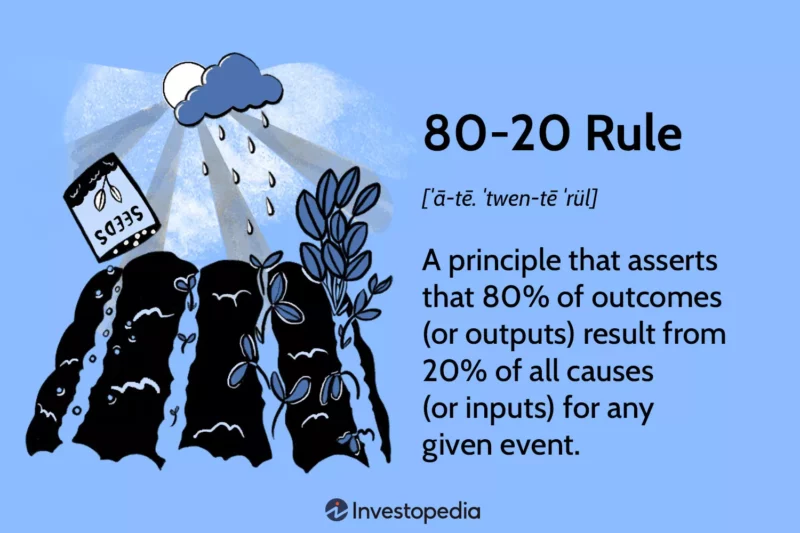
Land Connections – Hmmm, So What is This 80/20 Rule?

A Brief History of the 80/20 Principle
“Okay, let me see your design.” I was fresh out of design school at the time and working on one of my first projects as a landscape designer in Boston. It was a couple days before a project deadline. The Principal Landscape Architect I was working with at the time asked me to draw up a list of remaining design issues from my standpoint.
After thinking for a minute, I answered “Here are the ten things I have left,” I said. “It was kind of hard to prioritize them though as they all seem really important.” I was fortunate to be working directly with a Principal who, in addition to being extremely patient with me, saw it as her responsibility to mold green design school graduates into fully functioning landscape architects.
“So you’re telling me that designing these custom bike racks and trash receptacles are as important as fine-tuning the overall site plan including the circulation system?” she asked.
“Well… I mean… no. Not when you put it that way…” I stammered.
“And,” she continued, “do you really think these smaller custom elements will bring as much to the project as ensuring the overall design works?”
“No, but…”
She held up her hand to save me any further embarrassment. “We have two days left. I want you to pick out the two issues from your list that will bring the most impact to the project. And then focus on ONLY those issues.
“Really?” I asked incredulously.
Instead of a sharp rebuke, she chuckled and said “A big part of our jobs as designers is to be aware of those parts of the project that are most important to the design. The parts that could make or break the project. And then focus on those areas relentlessly. Everything else is just a distraction.”
“OK, I understand… only the two most important things” I replied and headed back to my desk.
So I quickly got over my wounded pride and got back to work. The project didn’t win any design accolades but the clients were happy with the outcomes and hired us to do another project for them soon after.
Although I didn’t know it at the time, this was my first introduction to the 80/20 rule.

We all deal with numerous tasks on a daily basis, striving to achieve excellent results in all. Have you ever wondered however, why if you’re doing multiple tasks, only few of them turn out to be vastly more important than the others with regards to measurable results or satisfaction?
“The important thing is the 80/20 rule: 80% of the effects come from 20% of the causes. This means that if you’re doing ten tasks, two are going to turn out to be vastly more important than the others.” – Brian Tracy
The above phenomenon can be explained to a large degree by what is known as the Pareto Principle, also commonly known as the 80/20 rule. This principle, first used in macro-economics, was introduced in 1906 by the Italian economist Vilfredo Paredo who noticed that 20% of pea pods in his garden were responsible for 80% of the peas. This principle is also called “the vital few and the trivial many.”
Real World Examples
One might wonder however, how to effectively apply this maxim in the context of a design and engineering firm. One of the benefits of the 80/20 rule is that it is a general rule of thumb that can be applied to various contexts; the idea being that once managers identify factors that are critical to a company’s success, they can strive towards giving those factors their most focus.
- Marketing Efforts: A close analysis reveals that 20% of marketing efforts frequently represent 80% of successes. It’s important to look for the invisible 20%—it’s there, find it! If a business activity succeeds beyond expectations, that is a 20% activity for sure—and likely to have much further to run. This mindset can help design firms focus (or re-direct) efforts to finding their most profitable clients.
- Time Management: The 80/20 principle also overturns conventional wisdom about time and believes that there is no shortage of time. In fact, most of us are positively awash in it. However, most people (me included) frequently get bogged down by time-consuming activities that in hindsight turn out to be less impactful. It has been seen that it is invariably tiny amounts of focused time that make all the difference. By identifying and prioritizing those high-impact tasks, design professionals can strive to become more productive.
- The construction process and quality control: A careful analysis of RFIs (Requests for Information) also reveals the same pattern. In many instances, 80% of them come from deficiencies in certain narrow areas of a project’s scope. In quality control, the same rule can be used to identify the vital few items that are responsible for a majority of issues or errors seen during the design process (or during construction). Addressing these critical factors early on can lead to significant improvements in the overall quality of our work.
- Project Management: All Project Managers know that most projects are inherently complex in more ways than one; there might not only be a central theme but also a series of satellite concerns to think about. The greater the number of project’s aims, the greater the efforts (and complexity) to accomplish that project satisfactorily. It has still been seen that 80% of the value of a project will come from just 20% of its aims (and associated activities to support that aim). The lesson here is not to start a project until one has stripped it down to just one or two simple aims (or goals). Jettison the baggage!

Conclusion

It’s important to mention also that the specific numbers here are not important (80% and 20% that is) and not always accurate. This rule is not a hard-and-fast law. However, it has been shown to act as a useful guideline for understanding and optimizing various aspects of decision-making by being able to identify and focus on the most impactful factors to achieve desired outcomes more efficiently, whatever they may be.
It’s easy to get caught up in the minutia of our daily tasks and lose sight of what really matters. Likewise, it’s easy to treat all tasks on one’s list as having equal importance. Instead, take a critical look at what you’re doing and focus relentlessly on those few things that really matter.
What’s important also is to recognize that practicing 80/20 is a skill that takes a while to develop. At first, it’ll invariably be difficult to let go of some tasks you once thought were important. Eventually, however, you’ll develop an intuitive understanding of what is valuable and what is most likely not the best use of your time. Whenever you’re faced with a new potential project or task, try to ask yourself this simple question: “Does this task help or hurt my 80% activities?”
Sources
- https://www.investopedia.com/terms/1/80-20-rule.asp
- https://neumannmonson.com/blog/when-make-changes-design-80-20-rule
- https://fourminutebooks.com/the-80-20-principle-summary/#:~:text=1%2DSentence%2DSummary%3A%20The,you%20embrace%20the%20Pareto%20principle.
- https://www.archdaily.com/791908/the-80-20-rule-the-key-to-producing-better-work-in-less-time
- The 80/20 Principle (3rd Edition); Richard Koch
About the Author

Samir Khanna, PLA, LEED AP, RQP is a Senior Landscape Architect at O’Dell Engineering’s Pleasanton office. He has over 23 years of experience in the industry and holds a Master of Landscape Architecture from Harvard University. He advocates for an integrated and informed approach to planning and design through ideas that expand upon the notion of overlapping context, landscape, infrastructure, and architecture.
Learn More
For previous Land Connections articles, click here.
For information on joining the O’Dell Engineering team, click here.
To see our landscape architecture project experience, click here.
Go Back